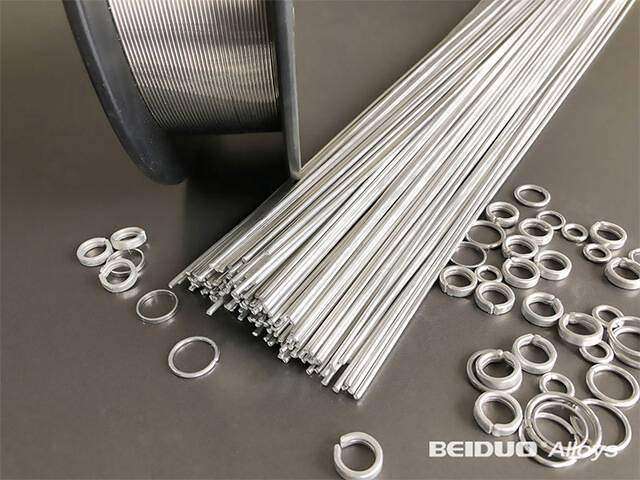
Can be used for brazing and for the Oxy-Fuel Gas Braze-Welding process, with liquid flux spread through the torch flame. Brass Brazing Alloys are mainly used for welding among copper, steel and iron. Most of the common (and easy to use) brazing alloys. It’s a low cost and good physical ability brazing alloy for brazing carbon steel, cast iron, hard carbide tools etc. Brass brazing alloys are widely used in bicycle frame, diamond tools, metal process, marine repair industries. BEIDUO Alloys offers an extensive range of copper and silver brazing alloys to suit your welding applications, a wide variety of brazing, welding and soldering alloys for joining most applications encountered in the field.

A general purpose Flux Coated Rod that combines flux and the brazing filler metal into a single form. It’s ideal for everyday repairs of steel, cast iron and copper metals. Can save labor cost. With highly versatile and strong, it’s widely used for Oxygen/Acetylene Welding/Brazing and can also be used on galvanized iron, brass, stainless, copper and chrome-plated materials, or any combination of them. Provides strong corrosion resistance. This rod can be used to join similar and also dissimilar metals such as mild steel to galvanized steel, stainless steel to copper, mild steel to stainless, stainless to copper nickel and mild steel to cast iron. Welding Material should be heated evenly to brazing temperature, avoid putting direct flame onto flux coating.

The Phosphorus Copper alloys are extensively used to join copper and copper alloy base metals (brass, bronzes). Phos-Copper is extensively used in Non-Ferrous Industry. They have self-fluxing properties when used on copper and may or may not contain Silver. Continuous service operating temperatures of joints brazed with these alloys range up to approx 200 °C. Corrosion resistance is satisfactory, except when the joints are exposed to sulfurous environments, especially at elevated temperatures. Phosphorous Copper alloys should not be used on ferrous, nickel based alloys, or copper-nickel alloys with more of 10% nickel, in order to avoid premature failure of the joint due to the formation of brittle intermetallic phases.

Silver brazing alloys, suitable to join easily a wide range of ferrous and non-ferrous base materials (iron, steel, stainless steel, copper, brass, etc.). Available in many different presentation forms (rods, flux-coated rods, wires, strips, rings, preforms, pastes and powders), these alloys are very free flowing, ductile and strong. High sliver brazing alloys often chosen for its low temperature, good wetting and good flow. Suitable for torch brazing with manual feed, where heating may be inconsistent. For steel, copper and copper alloys, nickel and nickel alloys; for joining ferrous, nonferrous and dissimilar alloys with narrow tolerances.

The aluminum flux cored wire consists of aluminum silicate alloy in strip form that is rolled around a white, powdered fluoride flux. The flux is non-corrosive and non-hygroscopic. It ‘s used to braze for joining copper to aluminum, brass to aluminum and aluminum to aluminum by flame brazing, induction brazing and furnace brazing. We have supplied the materials used by flame brazing, induction brazing and furnace brazing for air conditionersevaporators, condensers, compressors, refrigerators, freezers, ice machines, etc.

The Cu-Al flux cored wire consists of a Zn-Al alloy in strip form that is rolled around a white, powdered fluoride flux. The flux is non-corrosive and non-hygroscopic, It’s used to braze for joining copper to aluminum, brass to aluminum and aluminum to aluminum by flame brazing, induction brazing and furnace brazing. It’s the ideal brazing material for joining copper tube to aluminum tube at pressent in refrigeration industry.

Application: Zinc aluminum alloy (Zinc/Aluminum, Zn/Al) is often used as protective coating in steel and iron parts. Compared with zinc wire and pure aluminum wire, it has better coherence. Due to its resistance to wear and corrosion resistivity, Zn/Al alloy is an ideal anticorrosion material to sea water. Zinc Aluminum alloy is often widely used in thermal spraying, traffic equipement, poles and towers. It can also used for container, bridge, head frame, storage tank and electric iron tower. Meanwhile, it’s a good choice for capacitor, metal bracket, nodular cast iron pipe, too.

Very high temperature brazing of steels, hard metal and carbides. Alloys especially suited to the brazing of rock-drilling tools.

The brazing and soldering flux series includes: silver brazing fluxes, copper brazing fluxes, aluminum brazing fluxes and environmental-friendly non-corrosive aluminum brazing fluxes, etc... These are available as powder, paste or liquid.

Oxygen-free copper (OFC) or oxygen-free high thermal conductivity (OFHC) copper is a group of wrought high-conductivity copper alloys that have been electrolytically refined to reduce the level of oxygen to 0.001% or below. Application: low oxygen and impurity content, high purity, electrical conductivity.

Brazing is a common method of joining two or more metals by heating the base metal and adding a filler metal into the joint.
Depending on the applications, these filler metals can be made of materials such as copper, aluminum, stainless steel, silver, etc. Some of these filler metals are capable of joining dissimilar metals as well.
Beiduo Alloys offers an extensive selection of wires, rods, rings, strips, and pre-formed shaped filler metals for practically any brazing application. Often times these filler metals are used in hvac, construction of bicycle frames, diamond tooling, automotive and marine repair industries.